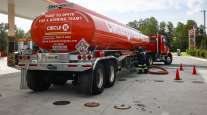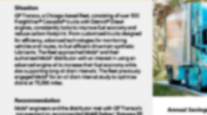Oil Industry Starts Eradicating Ship Fuel Supply Ahead of IMO Mandate

Shippers beware: Oil refineries are starting to eradicate stockpiles of sulfur-rich fuel that powers the merchant fleet in anticipation of a demand collapse in fewer than 18 months.
Stockpiles have slumped in the United States and Singapore this year, and traders directly involved in buying and selling the fuel say some refineries already started to trim output in anticipation of rules that will severely restrict consumption from Jan. 1, 2020.
The draw-down underscores a tricky balancing act for an oil market facing a once-in-a-generation shift in the kind of fuel it must supply. Refineries need to cut back on output before demand collapses at the start of 2020, but if they do so faster than consumption slides, then fuel-price volatility could increase. The market currently is trading in what is known as backwardation, where immediate prices are higher than later ones — a structure that can punish traders who store.
“It’s literally the perfect storm,” Nevyn Nah, a Singapore-based analyst at Energy Aspects, said of diminishing stockpiles. “Any fuel oil blender whose lease/storage lease is going to expire now will not be renewing it because of the backwardation.” That will limit the industry’s ability to produce suitable marine fuel, he said.
The oil market traditionally gauges the strength of different fuels based on where they are trading relative to crude. Ship fuel, or bunker as it is known, normally is at a discount because it’s a residue after turning crude into more valuable products such as gasoline and diesel.
Cracking Discount
In Europe, that discount, or crack, strengthened to $7.17 a barrel less than Brent crude, on July 31 from minus $14.30 in April, according to fair-value data compiled by Bloomberg. The price in January 2020 is at about a $24 discount.
The rule change, announced in October 2016 by the International Maritime Organization, will limit the sulfur content of bunker fuels to 0.5% starting Jan. 1, 2020, unless vessels have installed scrubbing equipment. The current limit in most parts of the world is 3.5%. The pollutant is blamed for human health conditions such as asthma.
Traders in Singapore say that a second reason for diminished stockpiles there is because some fuels don’t meet the necessary specification.
In the United States, they are at 28.7 million, the lowest for the time of year in at least three decades, Energy Information Administration data show. Bunker-fuel inventories in Singapore, a major global refueling hub for shipping, have dropped to a nine-year low of 14.8 million barrels, according to International Enterprise Singapore.
The backwardation in prices also is hitting a regular fuel oil arbitrage trade to Singapore from Europe, according to Nah at Energy Aspects. Relatively few very large crude carriers, or VLCCs, plowed the route around South Africa’s Cape of Good Hope since March, he said.
The backwardated price structure means traders favor making cargo deliveries as quickly as possible, which means using Egypt’s Suez Canal, Nah said. However, the industry’s biggest ships can’t navigate the waterway fully laden, so smaller carriers are being used — and they are dropping off supplies in the Middle East instead, he said.
With assistance by Claudia Carpenter




